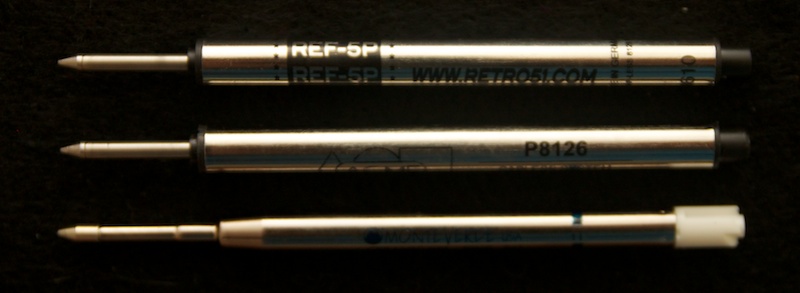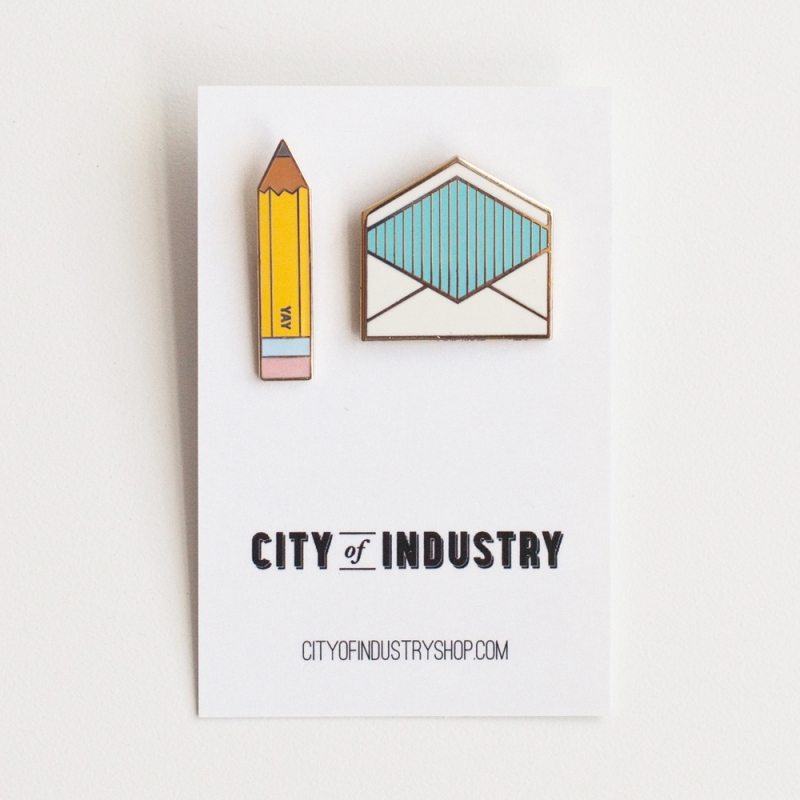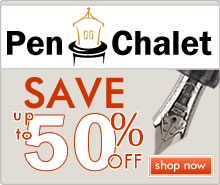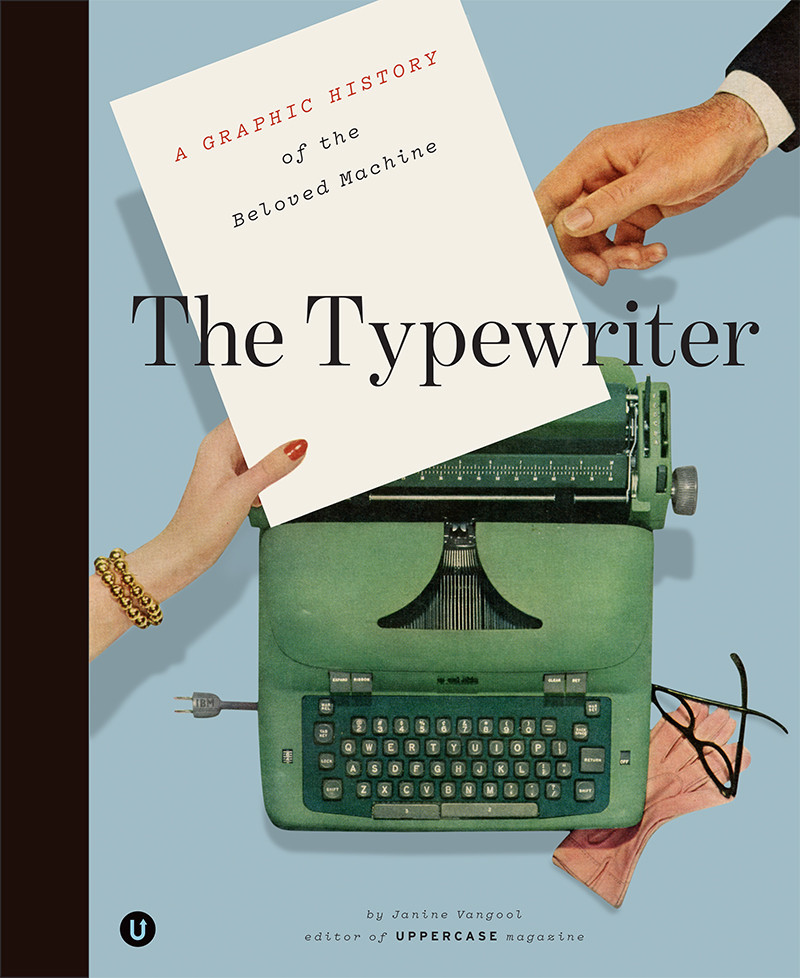Lots of pens available these days accept either a “Parker-Style” G2 refills, a Pilot G2 refill (adds to the confusion for sure) and the Pilot Hi-Tec C style refills. I thought I’d try to come up with a list of refills that fit into these categories. This is by no means a definitive list but should provide you with lots of options for your favorite non-fountain pens.

There are so many potential options for a “Parker-style” refill (which annoyingly enough is also referred to as a G2 though it is not necessarily compatible with a PILOT G2 style pen). The G2 refill is 98mm long and approx 5.8mm diameter on the main barrel.

Parker Style Refills
Here’s a list of most (but probably not all) of the Parker-style refills:
- Diplomat EasyFLOW Ballpoint Pen Refill
- Faber-Castell Ballpoint Pen Refill
- Faber-Castell Scribero Gel Ink Roller Refill
- Fisher Space Pen Refill, PR Series- Colors (Bold, Medium, Fine)
- Fisher Space Pen – Universal Ballpoint Refill
- Foray (Office Depot) Ballpoint Refill for Parker (Medium)
- Itoya Aquaroller Refill (0.7 and 1.0mm)
- Kaweco Soul G2 Refill 1.0mm
- Kaweco Sport Roller Ball Pen Refill
- Moleskine Ballpoint Refill
- Moleskine Gel Refill (0.5 and 0.7 mm)
- Moleskine Roller Gel Fluorescent Refills
- Monteverde Ceramic Gel Refill (Broad)
- Monteverde Needle Point Refill (Fine)
- Monteverde Soft Roll- Colored inks (Medium)
- Monteverde Soft Roll- (Superbroad, Medium, Ultrafine)
- OHTO Needlepoint Ballpoint Pen Refill PS-807NP
- OHTO PS-205NP Extra-Fine 0.5mm Ballpoint Pen Refill
- Parafernalia Ballpoint Pen Refill NO LOGO
- Parker Ballpoint Pen Refill (Broad, Medium, Fine)
- Parker GEL Ballpoint Pen Refill (Medium)
- Parker Quinkflow Ballpoint Pen Refill (Medium, Fine)
- Pelikan Giant Ballpoint Pen Refill 337 (Broad, Fine, Medium)
- Pentel KFLT8 Ballpoint Pen Refill
- Platignum Standard Ballpoint Pen Refill
- Premec Parker-Style G2 Gel Refill (0.4, 0.5 and 0.7 mm)
- Retro 51 Tornado Roller Ball Refills (REF5P) (Made by Schmidt)
- Schmidt 9000M EasyFlow Pen Refill
- Schmidt P8126 Capless Rollerball (Fine)
- Schmidt P8900 Super Bowl Refill (Fine)
- Schmidt P900 B Ballpoint Pen Refill (Broad, Medium, Fine)
- Schmidt P950M Megaline Pressurized Ballpoint Pen Refill (Medium)
- Schneider Express 735 Pen Refill (Broad, Medium, Fine)
- Schneider Slider 755 Pen Refill (Extra-Broad, Medium)
- STABILO EASYgel Refill
- Stabilo Ballpoint Refill
- Tombow BR-ZLM Ballpoint Pen Refill
- Visconti Ballpoint Pen Refill AA49 1.4 (Broad)
- Visconti Gel Refill (Broad, Medium, Fine)

Mike Rohde of Sketchnoting fame hacked a Pentel Energel refill (normally a Pilot G-2 sized refill) to fit into his Retro 51 by trimming the end of the refill to be the right size. If you’re willing to experiment, other refills might also survive this sort of hack. I’ve hacked the end off a few refills in my time to make them fit as well. Just grab a craft or utility knife or a sturdy pair of scissors, line up the old refill and the new refill and snip. Voila.
If you love a particular sort of pen refill, you can also lengthen a refill that’s too short by adding a bit of plastic tubing to the end of the barrel. The fine folks at Karas Kustoms provide a length of plastic tubing with their Render K, RETRAKT and BOLT pens that could be used with other brands as well or you could snip off a section of an empty plastic refill to length a new refill to fit.
The best source I found for ALL the Parker-style refills was Cult Pens in the UK. They stock over 30 different styles of Parker-style refills. Another option is Refill Finder.

G2/Schmidt/Euro Rollerball (and similar) Refills:
The Euro G2-style refill (very similar to the Pilot G2 but not always the same because of the plastic housing around the metal tip shaft). In some pens with enough clearance, they can be interchanged but of your pen has tight interior clearance, some Japanese refills (highlighted in orange) will not be interchangeable with the European counterparts.
Also described as the Schmidt/Euro Rollerball refill size are about 110mm long:
- Caran d’Ache Fibre Tip Refill
- Caran d’Ache Rollerball Refill
- Faber-Castell Rollerball Pen Refill
- Faber-Castell Fineliner Pen Refill
- FORAY (Office Depot) Pen Refill For Schmidt Rollerball
- Kaweco “soul” refill G2
- Kaweco G2 Gel Roller Pen Refill
- Hi-Tec-C Cavalier refill
- Monteverde Fineliner Refill G52
- Monteverde Ceramic Rollerball Refill W22
- Monteverde Spring-Loaded Tip Fineliner Refill G62
- OHTO Ceramic Rollerball Pen Refill
- OHTO F-300 Fude Refill Black
- Pentel LR7 Energel
- Pilot Frixion Erasable Gel
- Pilot Juice (removed from plastic retractable pen)
- Pilot G2
- Pilot LP2RF Gel Refill (Juice refill code)
- Premec Roller Refill (0.5mm and 0.7mm)
- Schmidt Capless Rollerball 8126 and 8127 (shorter models can work with an extension hack)
- Schmidt 6040 FineLiner refill
- Schmidt 888 Safety Rollingball Ceramic Plastic refill
- Schmidt 5888 Safety RollingBall Ceramic Metal Tube refill
- Schmidt 5285 Safety Rolling Tube Needlepoint Tip
- Schneider Topball 850 Pen Refill
- Schneider Topliner 970 Pen Refill
- Sheaffer Fineliner Refill
- Visconti Rollerball Pen Refill AA40 0.7
- Zebra JT refill
- Zebra Sarasa Clip refill (removed from plastic retractable pen)
Using a spring around the tip of the refill will help to stabilize these. Use either the spring provided by your pen manufacturer or steal one from a retractable plastic pen body to get the perfect fit.
Cult Pens has a great selection of these refills in their “Euro Refills” section.

Pilot Hi-Tec C Refills:
The Pilot Hi-Tec C style refills list doesn’t look as extensive as the other refill styles but the Hi-Tec C line has a huge assortment of color options and tip widths to provide quite a variety. The Pilot Hi-Tec C refills can be purchased individually or liberated from any Pilot Hi-Tec C pen including the Maica line.
- Pilot Hi-Tec C (available in 0.25, 0.3, 0.4, 0.5)
- Pilot G-Tec C (same as the Hi-Tec C but renamed for the American/European market)
- Uni-ball Signo UM-100 Gel
- Uni-ball Signo DX UM-151 Gel
- Uni-ball Signo Broad UM-153 Gel
I’ve found that the Uni-Ball Signo refills may need to be trimmed slightly to fit but they work great. Just use scissors, a craft knife or blade to shorten the length to match the original length. I liberate Signo refills from plastic pens found around my office as well as occasionally purchasing proper refills.
D1 Refills:

Then there’s the D1 sized refills. These are the super slender and used in multi-pens and mini pens. The Sharbo-X is a great example as is the Retro 51 Tornado Touch.
The D-1 mini refills are about 66-67mm long and there are quite a few refill styles to fit into these pens:
- Acme Black 4FP Four-Function Pen Ballpoint Pen Refill
- Acme Highlighter 4FP Four-Function Pen Multi Functional Pen Refill
- Aurora Mini Medium Point Ballpoint Pen Refill
- Caran D’ache Ecridor XS Mini Refill
- Cross Matrix Ballpoint Pen Refill
- Cross Micro Ballpoint Pen Refill
- Kaweco D1 Soul Ballpoint Refill
- Monteverde Soft Roll Ballpoint Pen Refill – D1 (628)
- Ohto R-4C7NP Needle-Point Ballpoint Pen Refill
- Parker Mini Ballpoint Refills
- Parker Vector 3-in-1 Ballpoint Refills
- Pelikan 38 Ballpoint Refills
- Pilot BRF-8M Ballpoint Pen Refill
- Platinum BSP-60 Series
- Platinum BSP-100
- Retro 1951 D-1 Ballpoint Refill
- Rotring Tikky 3-in-1 2-Color Ballpoint Refills
- Tombow VS Ballpoint Pen Refill – D1
- Uni SXR-200 Jetstream Ballpoint Multi Pen Refill (0.5 and 0.7mm)
- Zebra 4C-0.7 Ballpoint Pen Refill
- Zebra Sharbo X Ballpoint Multi Pen Refill Component – D1
- Zebra Sharbo X Gel Ink Multi Pen Refill Component (0.4 and 0.5mm) – D1
Another option to consider:
Tofty on Shapeways creates 3D printed sleeves for many proprietary refills that allow you to use a D1 refill instead of the harder to find Lamy, Diplomat, Caran d’Ache and others. He will also work to make a custom 3D printed sleeve to meet your needs if you email him directly. I’ve ordered several pieces from him and they work really well and have allowed me to use the Zebra Sharbo-X extra fine gel refills in my Fisher Space Pens. This is 21st century pen hacking at its finest!
Big thank you to my pal Dan for giving me a list as a starting point. Thanks to The Pen Place in Kansas City for letting me try out lots of refills. The rest of my info came from Jet Pens, Cult Pens and Refill Finder.
Monteverde is modifying some of their refills to fit pens with more proprietary sizes like Lamy. Lamy is the most finicky of all the pens. If you have good alternatives for refills for Lamy rollerball and ballpoint pens, let me know.
Don’t forget to check your local office supply or pen store (even those big box shops) and play around with the pens and refills you have. You’d be surprised what might work.
I’m working on a handy printable pocket guide of all these pen refill options but I want to make sure I haven’t left anything out or gotten anything wrong. So let me know which of these refills work for you and which don’t.
Note: I have not tried EVERY refill with every pen so your results might vary. Please leave notes in the comments about your favorite pen and refill combination for other readers. Thanks!















